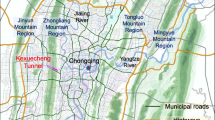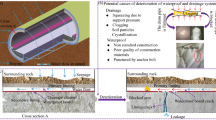Abstract
In the presence of heavy rainfall on the earth’s surface, a series of water-induced problems often appear in karst tunnels, such as lining cracks and invert uplift. An effective method of alleviating these problems is the adjustment of the tunnel drainage scheme. In this study, three waterproofing and drainage optimization schemes were studied using numerical simulation and model tests. Numerical results show that, when the conventional waterproofing and drainage scheme is adopted in water-rich karst tunnels, the water pressure at the tunnel invert cannot be effectively reduced by the drainage system. When the water head height of the tunnel crown is 50 m and the distance between circumferential drainage blind pipes is reduced from 5 to 2 m, the rate of water pressure reduction at the invert from 21 to 27%. When a longitudinal drainage blind pipe is added at the bottom of the invert, the rate of reduction is increased to 84%; however, it is increased to 96% when the central drainage ditch is set at the bottom of the invert. Therefore, placing the central drainage ditch at the bottom of the invert has the most significant effect on reducing the water pressure. Model test results indicate that when the water head height of the tunnel crown is 12 m, the reduction rates of water pressure at the invert corresponding to the placement of a central drainage ditch at the bottom of the invert are 66%. The model test results were found to be consistent with numerical results.

















Similar content being viewed by others
References
Akbarian E, Najafi B, Jafari M, Faizollahzadeh Ardabili S, Shamshirband S, Chau K (2018) Experimental and computational fluid dynamics-based numerical simulation of using natural gas in a dual-fueled diesel engine. Eng Appl Comput Fluid Mech 12(1):517–534
Casagrande G, Cucchi F, Zini L (2005) Hazard connected to railway tunnel construction in karstic area: applied geomorphological and hydrogeological surveys. Nat Hazard Earth Sys 5:243–250
Chau KW, Jiang YW (2002) Three-dimensional pollutant transport model for the Pearl River Estuary. Water Res 36(8):2029–2039
Fan HB, Zhang YH, He SY, Wang K, Wang XL, Wang H (2018) Hazards and treatment of karst tunneling in Qinling-Daba mountainous area: overview and lessons learnt from Yichang-Wanzhou railway system. Environ Earth Sci 77:679
Fang Y, Guo JN, Grasmick J, Mooney M (2016) The effect of external water pressure on the liner behavior of large cross-section tunnels. Tunn Undergr Sp Tech 60:80–95
Fu G, Cao YP, Zhang L, Zhang CY, Liu HW (2007) The idea of underground water environmental balance applied to the design of the tunnel under high hydrostatic pressures. Rock Soil Mech S1:474–478
Hu J, Wen H, Xie Q, Li B, Mo Q (2019) Effects of seepage and weak interlayer on the failure modes of surrounding rock: model tests and numerical analysis. Roy Soc Open Sci 6:190790
Hwang JH, Lu CC (2007) A semi-analytical method for analyzing the tunnel water inflow. Tunn Undergr Sp Tech 22:39–46
Jeon S, Kim J, Seo Y, Hong C (2004) Effect of a fault and weak plane on the stability of a tunnel in rock: a scaled model test and numerical analysis. Int J Rock Mech Min Sci 41:658–663
Lei MF, Peng LM, Shi CH (2015) Model test to investigate the failure mechanisms and lining stress characteristics of shallow buried tunnels under unsymmetrical loading. Tunn Undergr Sp Tech 46:64–75
Lei MF, Lin DY, Yang WC, Shi CH, Peng LM, Huang J (2016) Model test to investigate failure mechanism and loading characteristics of shallow-bias tunnels with small clear distance. J Cent South Univ 23:3312–3321
Li DY, Li XB, Li CC, Huang BR, Gong FQ, Zhang W (2009) Case studies of groundwater flow into tunnels and an innovative water-gathering system for water drainage. Tunn Undergr Sp Tech 24:260–268
Li SC, Zhou ZQ, Li LP, Xu ZH, Zhang QQ, Shi SS (2013) Risk assessment of water inrush in karst tunnels based on attribute synthetic evaluation system. Tunn Undergr Sp Tech 38:50–58
Li SC, Lin P, Xu ZH, Li LP, He SJ, Zhao SL, Huang X (2017a) Innovative method for the integral sliding stability analysis of filling media in karst caves and its applications in engineering. Int J Geomech 17:04017109
Li XZ, Zhang PX, He ZC, Huang Z, Cheng ML, Guo L (2017b) Identification of geological structure which induced heavy water and mud inrush in tunnel excavation: a case study on Lingjiao tunnel. Tunn Undergr Sp Tech 69:203–208
Li SC, Gao CL, Zhou ZQ, Li LP, Wang MX, Yuan YC, Wang J (2019) Analysis on the precursor information of water inrush in karst tunnels: a true triaxial model test study. Rock Mech Rock Eng 52:373–384
Ma D, Miao XX, Bai HB, Huang JH, Pu H, Wu Y, Zhang GM, Li JW (2016) Effect of mining on shear sidewall groundwater inrush hazard caused by seepage instability of the penetrated karst collapse pillar. Nat Hazards 82:73–93
Nam SW, Bobet A (2006) Liner stresses in deep tunnels below the water table [J]. Tunn Undergr Space Technol 21(6):626–635
Tian QY, Zhang JT, Zhang YL (2018) Similar simulation experiment of expressway tunnel in karst area. Constr Build Mater 176:1–13
Wang XY, Tan ZS, Wang MS, Zhang M, Huang FM (2008) Theoretical and experimental study of external water pressure on tunnel lining in controlled drainage under high water level. Tunn Undergr Sp Tech 23:552–560
Wu J, Li SC, Xu ZH, Huang X, Xue YG, Wang ZC, Li LP (2017) Flow characteristics and escape-route optimization after water inrush in a backward-excavated karst tunnel. Int J Geomech 17:04016096
Xiao XX, Xu M, Ding QZ, Kang XB, Xia Q, Du F (2018) Experimental study investigating deformation behavior in land overlying a karst cave caused by groundwater level changes. Environ Earth Sci 77:1–11
Yuan Y, Jiang X, Lee CF (2000) Tunnel waterproofing practices in China. Tunn Undergr Sp Tech 15:227–233
Yang GC, Wang XH, Wang XG, Cao YG (2016) Analyses of seepage problems in a subsea tunnel considering effects of grouting and lining structure. Mar Georesour Geotech 34:65–70
Ye F, Gou CF, Sun HD, Liu YP (2014) Model test study on effective ratio of segment transverse bending rigidity of shield tunnel. Tunn Undergr Sp Tech 41:193–205
Zhao Y, Tian SM (2019) Data statistics of railway tunnel in China up to the end of 2018. Tunn Constr 39:324–335
Zhao Y, Tian SM, Sun Y (2017) Development and planning of high-speed railway tunnels in china. Tunn Constr 37:11–17
Acknowledgements
This research is financially funded by Scientific and Technological Innovation Projects with Special Funds for Fundamental Scientific Research Business Fees of Central Universities (No. 2682019CX03), Natural Science Foundation of Hebei Province (No. E2020210068) and State Key laboratory of Mechanical Behavior and System Safety of Traffic Engineering Structures (No. ZZ2020-01).
Author information
Authors and Affiliations
Corresponding author
Ethics declarations
Conflict of interest
The authors declare that they have no conflict of interest.
Additional information
Publisher's Note
Springer Nature remains neutral with regard to jurisdictional claims in published maps and institutional affiliations.
Rights and permissions
About this article
Cite this article
Zhao, D., Fan, H., Jia, L. et al. Research on waterproofing and drainage optimization scheme for karst tunnel lining in water-rich areas. Environ Earth Sci 80, 150 (2021). https://doi.org/10.1007/s12665-021-09466-0
Received:
Accepted:
Published:
DOI: https://doi.org/10.1007/s12665-021-09466-0




